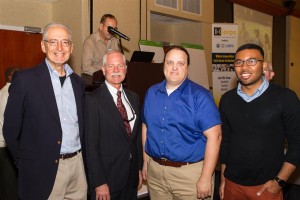Smart Phone Spectrometer
Dr. Richard Blair, a UCF researcher, is leading a team in developing a spectrometer that can be used with the camera of a smart phone to identify unknown substances. This analytical technology can be used in a variety of forensics, military and other field test applications. This technology will increase the speed and accuracy of field tests in analyzing the composition of unknown substances.
Faster, more accurate method to identify unknown substances in the field—smartphone spectrometer team.
The functionality of our smartphones is evolving at a rapid pace. They’ve become our calendars, watches, video cameras, sources of music, and connections to all our favorite social channels. A team taking part in the inaugural class of the UCF I-Corps program believes that smartphones also can play a crucial role in helping law enforcement professionals identify unknown substances.
The smartphone spectrometer team is developing a spectrometer and app that can be used in conjunction with the camera of a smartphone to quickly, safely and more accurately identify unknown substances. This analytical technology can be used in a variety of forensics, military and other field-test applications.
“We’re digitizing what traditionally has been an analog methodology,” said UCF graduate research assistant David Nash, who serves as the team’s Entrepreneurial Lead. “We anticipate that our technology and method will increase the speed and accuracy of field tests in analyzing the composition of unknown substances.”
In a typical situation, law enforcement professionals who need to determine the composition of an unknown substance often must conduct a complex and multi-step process to appropriately handle and gather the substance, conduct the test and interpret the results.
With the smartphone spectrometer team’s approach, the law enforcement professional uses a prepared test strip to sample the unknown substance and run it through the team’s spectrometer. The spectrometer features luminescence technology which creates a chemical/color signature of the substance. The smartphone camera is used to take a photo of this signature which is then read via an app, developed by the team, which determines the composition of the substance within seconds.
“We’re excited to be part of the UCF I-Corps program in our effort to better identify and understand the potential market,” said Nash. “It’s an outstanding hands-on opportunity to conduct market research, identify the specific needs our solution should address and build a prototype.”
Other team members include UCF Physics Department and CATER professor Richard Blair, Ph.D., who serves as the Principal Investigator, and industry veteran Terry Pierce who serves as Mentor.



